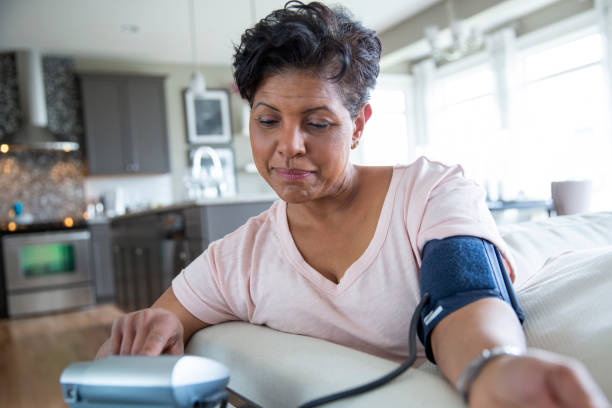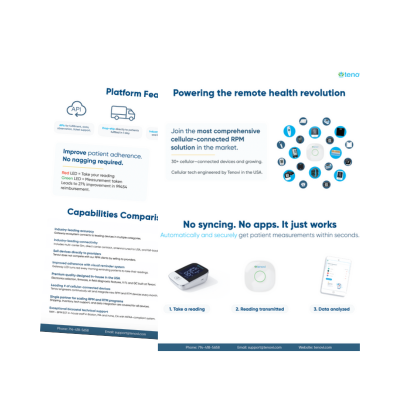Hypertension still affects more than 1.2 billion adults worldwide, and managing it effectively remains a major challenge. While medication is often the first line of defense, many patients continue to struggle with fluctuating blood pressure levels between visits to their provider. The rise of remote blood pressure monitoring is helping close that gap.
According to Harvard Business Review, telemedicine adoption has surged 89% of U.S. adults and 78% of adults globally have access to digital care solutions. Remote monitoring is no longer a niche tech solution; it’s becoming a standard approach in managing chronic conditions like hypertension.
Remote blood pressure monitoring is a digital hypertension management solution that delivers real-time data to clinicians and keeps patients engaged in their own care. This leads to more timely interventions, improved blood pressure control, reduced hospital admissions, and fewer costly complications. It’s not just good for clinical outcomes, it’s smart economics too.
In this article, we’ll unpack how remote blood pressure monitoring supports proactive hypertension management, strengthens patient-provider collaboration, and helps health systems shift from reactive to preventive care.
Risks Associated with Hypertension
Hypertension is a major contributing factor to heart disease. In the United States, 48%, or almost 116 million people, have hypertension. Furthermore, it is a significant risk factor for many chronic diseases, including:
- Heart attack
- Heart failure
- Kidney disease
- Stroke
- Vision loss
- Sexual dysfunction
Chronic diseases are the leading causes of illness, disability, and death in the United States. These conditions generally require hospitalization and can be very costly to treat. Thus accounting for our nation’s $4.5 trillion annual health expenditure. Yet, one of the easiest ways to help detect complications early and minimize the development of chronic disease is to measure blood pressure regularly.
How Does Remote Blood Pressure Monitoring Work?
Remote blood pressure monitoring is a digital health innovation that uses remote patient monitoring (RPM). RPM involves setting patients up with FDA-cleared remote patient monitoring devices to monitor vital signs from home. Depending on the patient’s condition, the device used will vary. A hypertensive patient may use a wireless RPM blood pressure monitor, while someone with diabetes uses a wireless blood glucose meter.
The RPM device automatically sends the vital sign data to a provider’s RPM platform. Then, the clinician accesses the data from a dashboard and acts upon the results as necessary. Clinicians can set thresholds to receive alerts if a patient’s reading is outside the set threshold. The platform automatically alerts the physician when a patient’s reading exceeds the specified limits.
Many times, people do not seek medical attention for complications until symptoms become debilitating or even life-threatening. With RPM, qualified healthcare professionals can stay on top of their patient’s vital signs between visits and deal with any complications immediately before they progress.
Who Can Benefit from Remote Blood Pressure Monitoring?
Hypertension typically develops over a gradual period and is often preventable by adopting a healthier diet, being physically active, and limiting alcohol consumption. However, it can sometimes be difficult for patients to commit to lifestyle changes between office visits. Remote blood pressure monitoring can help monitor these patients and those with a greater risk of developing hypertension, including:
- Individuals age 65+
- Pregnant patients managing hypertension
- Individuals with a family history of high blood pressure
- Cancer patients
With RPM, data accumulates quickly, and a patient’s health history develops. A patient’s blood pressure reading is stored in a remote patient monitoring portal. The data provides physicians with valuable insights for treating the patient. It also lets the patient see firsthand how lifestyle adjustments affect their blood pressure. Remote blood pressure monitoring engages the patient in managing their health.
Patient & Provider Benefits of Remote Blood Pressure Monitoring
Remote blood pressure monitoring benefits both patients and healthcare providers. RPM expands healthcare beyond the clinical setting into the patient’s everyday life. Four benefits of remote patient monitoring for blood pressure management include:
1. Provides Better Healthcare In Between Visits
A single blood pressure measurement can only tell a physician what an individual’s blood pressure is at that specific moment. Factors such as stress or forgetting to take medications can influence this measurement, giving the clinician an inaccurate representation of the patient’s health.
With remote BP monitoring, patients can measure their blood pressure regularly from their homes. Frequent readings give physicians a more precise representation of the patient’s blood pressure levels over time and help ensure effective treatments. For instance, for patients requiring remote blood pressure monitoring during pregnancy due to obstetric hypertension remote patient monitoring has, “improved linkages to clinician care after delivery when compared to historical controls,” according to the largest study on obstetric and perinatal outcomes with a remote patient monitoring program for hypertension.
2. Increases Patient Engagement
Remote blood pressure monitoring is a patient and caregiver solution that encourages involvement, health management and active engagement. Most RPM devices are user-friendly, work right out of the box, and ship directly to the patient. By making remote blood pressure monitoring as simple as possible, patients are not deterred from trying it.
For example, no syncing or app is required for Tenovi RPM devices. As a result, patients don’t have to worry about recording the information, and clinicians get access to data right away. Additionally, Tenovi devices utilize a cellular gateway.
This means multiple Bluetooth devices can connect to the Tenovi Gateway. The Tenovi blood pressure monitor automatically sends data through the Tenovi Cellular Gateway to the healthcare organization’s RPM platform.
Remote blood pressure monitoring holds patients accountable for taking their BP measurements regularly. Because the patients receive readings and know their care provider will regularly monitor their health, they’re more likely to adhere to their treatment plans and adopt healthier behaviors.
3. Reduces Costs
High blood pressure costs the nation about $131 to $198 billion annually. Moreover, by 2030, costs related to hypertension are predicted to triple to $389.9 billion. Additionally, indirect costs attributed to lost productivity (i.e., wait times, inefficient data collection, failure to identify health threats early on, etc.) are projected to double from $25.4 billion to $42.8 billion. By focusing on early identification and treatment, care providers can reduce the high costs of emergency room visits, tests, surgeries, and hospitalizations.
4. Generates More Revenue for Healthcare Organizations
Remote blood pressure monitoring allows healthcare providers to care for more patients by making healthcare more accessible, especially for those living in remote areas. Patients must attend all required in-person appointments. However, they don’t have to worry about setting blood pressure appointments, office wait times, or transportation costs. All they have to do is use their blood pressure monitor at least 16 days a month.
Similarly, clinicians can monitor patient health data at their convenience. Providers can bill for remote patient interactions, which adds to revenue generation. Under RPM CPT codes 99458 and 99457, physicians may reimburse for time spent on remote healthcare activities, such as collecting and reviewing patient data. Ultimately, RPM saves time and reduces costs for both the patient and the care provider, which helps clinicians care for more patients without necessarily spending more time.
Learn how to calculate expected revenue.»
The Next Step
Tenovi BPM offers an accurate and easy-to-use solution to boost workflow efficiency and patient satisfaction and generate revenue. Our easy-to-use devices automatically transmit data through our cellular gateway to help optimize care for chronic care management (CCM) patients with conditions such as heart disease, COPD, diabetes, kidney disease, and hypertension. Ready to see how Tenovi works in the real world? Request a free demo and discover how simple connected care can be.


